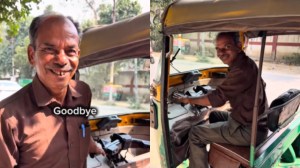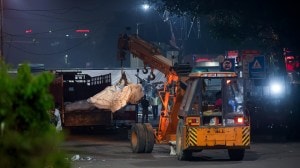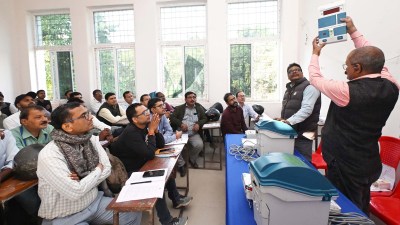Click here to join Express Pune WhatsApp channel and get a curated list of our stories
Maharashtra Assembly polls: As Pawars reign in Baramati, constituency’s dry zone locked in endless wait for water tankers
Despite having repeatedly elected leaders like Sharad Pawar, Ajit Pawar and Supriya Sule, 22 villages in Baramati’s dry zone have seen no relief in their decades-long struggle for water.
 People in Baramati city are relatively more ‘fortunate’ as they get water for at least one or two hours every day. (Express Photo)
People in Baramati city are relatively more ‘fortunate’ as they get water for at least one or two hours every day. (Express Photo)When travelling from Pune towards Baramati city, Ambi Budruk is among the 22 villages that are part of the dry zone of Baramati, Sharad Pawar’s family bastion. Like many other villages, voters in Ambi Budruk have been locked in an unending struggle to obtain water for drinking and farming purposes. The situation is so severe that youths in these villages struggle to find brides.
“A few days after my relative’s wedding was fixed, the bride’s family called it off because the woman was unwilling to get married to a village where people struggle for drinking water. She said this is a ‘bhukkad (hungry)’ village and she won’t be able to survive here,” recalls Sangeeta Jedhe, who hails from a family dependent on farming in Ambi Budruk.
The Janai Water Scheme, launched in 2000 to address the water requirements of the 22 villages and estimated to cost Rs 51 crore, is nowhere close to providing the necessary relief to residents. The cost of the project has now shot up to Rs 450 crore, yet there appears to be no sign of completion.
Jedhe highlights the trauma of voters living in the dry zone of Baramati constituency which has faithfully elected Pawar family members several times since 1967. Sharad Pawar has served as the region’s MLA as well as Lok Sabha MP and proudly states that he has been elected 14 times from Baramati.
His nephew and Deputy Chief Minister Ajit Pawar has been a legislator from Baramati seven consecutive times. Supriya Sule, daughter of the NCP(SP) national president, has been Baramati MP four times. The region’s water woes continued even when Sharad Pawar served as Maharashtra chief minister and held several other important positions, not to mention Ajit’s roles.
 Villagers of Ambi Budruk narrating their woes. (Express Photo)
Villagers of Ambi Budruk narrating their woes. (Express Photo)
That youths from the 22 villages here struggle to find brides is hardly a recent development. “It has been happening for years. Who wants to marry into a family which has no water to drink, bath or go to the toilet,” says Jayshree Jadhav of Ambi Budruk.
Jadhav says that the water that they currently manage to get every four-five days is unfit for consumption. “It is salty and tastes bad…,” she adds.
People in Baramati city are relatively more ‘fortunate’ as they get water for at least one or two hours every day. Borewells in the villages have water for two-three months after the monsoon, but come January, these wells start to dry up. From February to July, the villagers are dependent on water supplied through tankers that mostly arrive at odds hours. Getting clean drinking water, like in Baramati city, is simply out of the question for them.
A visit to some of the villages reveals their plight. The Karha River, which flows through this belt, is mostly dry, with rocks and dry patches of land in some places. Wilting crops strike the eyes as one moves through a narrow road dividing the vast expanse of farms on either side.
Most villagers own two to three acres of land if not more, but farming is a loss-making activity for them. The crops they manage to grow help them to survive for a few months, most of it withering away due to the lack of water. Some have taken to ancillary activities like poultry business to sustain their families. Hoteliers say they have to purchase water from tankers which leaves a huge dent in profits. Their children migrate to Pune city or even Mumbai in search of jobs.
Located just 33 km from Baramati city, Morgaon – famous for the Morgaoncha Moreshwar Ganpati temple – is one among these villages. Chhaya Shinde, whose family runs a restaurant, says, “Water is a luxury item for us. Farming is unthinkable in this dry belt. We have to spend Rs 1,100 to purchase water every two to three days. We use it for our business and for drinking purposes. We must be spending Rs 10,000 to Rs 15,000 every month just to purchase water, eating a hole into our profits.”
“Every household in Morgaon, which has a population of more than 1,200, has to purchase tanker water. Not everyone can afford it. Four or five families come together and jointly purchase tanker water as per the need,” says Chhaya’s husband Nilesh Shinde.
Every four days, villagers in Morgaon get tap water for 10-15 minutes. “This is hardly sufficient for one family. Imagine the problem we face when guests arrive or when we have a family event,” he explains. Morgaon and a few other villages get water from the Nazare dam.
Other villages and hamlets battling drought conditions throughout the year include Khandu Khairewadi, Jalgaon Supe, Ambi Khurd, Chandgude Vasti, Pansare Vasti, Supa Parghana, Songaon Supe, Undawadi KP, Kutwalwadi, Undawadi Gavlachi, Chaudhari Vasti, Karhati, Bharanpur, Supa, Dundwadi, Ambi Budruk, Murti, Modhave, Jalgaon KP and Tardawali.
Vast acres of farmland with wilting or burnt crops are visible everywhere in this arid zone even as human movement, vehicular traffic, hotels, institutes or schools are hard to locate.
A few kilometres from Morgaon, villagers in Supe seem to be breathing somewhat easy. “Our village is in a better position than others in this dry belt. We get water from the Khadakwasla canal. The water is lifted at Varvand and brought to Dundwadi through a closed pipeline. From there, it is supplied to villagers in Supe through the canal. We get drinking water for a few minutes a day,” Supe sarpanch Tushar Hirve tells The Indian Express.
Pointing out that the canal was constructed for a few more villages, Hirve, however, says its work has remained incomplete for over two decades now. “There were protests demanding that the canal should be extended to more villages. Some villages demanded that a closed pipeline should not be constructed. Then there was a fund problem. Because of several reasons, the project has been incomplete. We feel that once the Janai project is complete, the water woes of 22 villages will reduce drastically.”
Villagers in Supe say that they can cultivate Rabi crops after receiving some rain during monsoon. “Kharif crops are impossible without a source of water,” Hirve adds.
Ashwini Kashid, a homemaker in Ambi Khurd, says things are manageable till December. “This is because there is water in the borewell. But from January to July, it is a hard battle as there will be no water in the borewell. We have to wait endlessly for tankers to arrive.”
Once again this year, Supriya Sule won the election from the Baramati Lok Sabha seat, repeating vows to improve the water situation in these villages and now – as the Assembly polls approach – it is the turn of Ajit Pawar and his nephew Yugendra Pawar.
The voters, however, do not speak with anger against the Pawars for reasons best known to them. “They have been promising to implement water schemes. We have nothing against anyone. We only hope the Janai water scheme is implemented at the earliest so that our troubles are eased,” the Shinde family says.
Maharashtra is all set to vote in the Assembly polls on November 20, while the counting is slated for November 23.
Click here to join Express Pune WhatsApp channel and get a curated list of our stories







